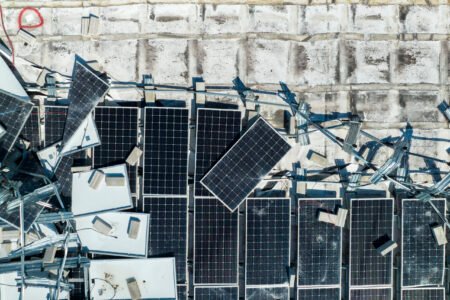Which is more efficient at harvesting the sun’s energy, plants or solar cells?
This salient question and an answer are the subject of an article published in the May 13 issue of the journal Science.
Although both photosynthesis and photovoltaics harvest energy from the sun, they operate in distinctly different ways producing different fuels. It is not a simple task to find common ground between the two in order to compare energy conversion efficiency.
“In order to make meaningful comparisons between photosynthesis (which provides stored chemical potential) and photovoltaic technology (which provides instantaneous electrical power), we considered photovoltaic driven water electrolysis to yield hydrogen using existing technology as an example of artificial photosynthesis,” explained co-author Thomas Moore, director of the Center for Bioenergy and Photosynthesis at ASU.
“The hydrogen produced by the artificial system is thermodynamically equivalent to the sugar produced by photosynthesis. The take-home from this point is that the artificial system out performs the natural one, but on the basis of potential for efficient solar energy conversion as measured by the land area required for a given energy output, both technological and biological processes could in principle offer similar outcomes.”
Photovoltaic technology uses fundamental principles combined with advances in materials to achieve record efficiencies of solar-to-electrical power conversion and thereby hydrogen production from water electrolysis.
Photosynthesis, on the other hand, originated in an environment where it was rapidly selected for, as it provided early life forms with a means of self-contained energy production. However, as with many evolutionary adaptations, it is far from a perfect, ideal system for the production of energy, and certainly is not optimal for providing solar-derived fuel to support human activities and economies.
All natural photosynthetic organisms contain light-gathering antenna systems in which specialized pigments (typically several hundred molecules) collect energy and transfer it to a reaction center where photochemistry takes place.
With so many pigments absorbing light energy, the capacity of the photosynthetic apparatus to process the energy is quickly exceeded. In leaves in full sun, up to 80 percent of the absorbed energy must be dumped to avoid its diversion into toxic chemical reactions that could damage or even kill the plant.
Modern agriculture has pushed photosynthesis about as far as it can go based on incremental improvements such as selection for high yield crops, land use improvements, use of modern fertilizers, water use, pesticides to control pests, and in short, the green revolution and all that it entails.
“We have identified many of the important inefficiencies that arise from the basic design of photosynthesis and have suggested ways to reengineer photosynthesis to improve its ability to meet human energy needs,” said Moore, a Regents’ Professor in the Department of Chemistry and Biochemistry in the College of Liberal Arts and Sciences.
“These improvements to photosynthesis go beyond the incremental steps practiced since agriculture began thousands of years ago,” Moore said. “At the end we allude to the use of synthetic biology to bring the knowledge and experience from fundamental studies in physics and artificial photosynthesis to photosynthesis in a combination of biology with technology to meet human energy needs.”
Operating at approximately 133 trillion watts (or terawatts), photosynthesis powers the biosphere and thereby life on Earth. Currently, human activity appropriates about 24 percent of photosynthetic net primary production (NPP) to support the U.S. gross domestic product and nutrition.
The cost to the biosphere of “our cut” of NPP is driving several Earth systems irreversibly across boundaries that were established over geological time scales, says Moore. Earth systems affected include the nitrogen cycle, carbon cycle, fresh water, land use, and an increase in the rate of biodiversity loss. In other words, photosynthetic energy flow is currently booked (almost certainly overbooked) for biosphere services including food and limited bioenergy production for human use. As a consequence, there are no reserves of photosynthetic capacity to provide increasing amounts of biofuel for growing our GDP and food for the ever-increasing human population. Indeed, when such demands are made, the capacity comes at the further peril of biosphere services.
“Fortunately, the efficiency of photosynthetic NPP could be dramatically improved to meet human needs – the 133 terawatts increased to about 150 terawatts with minimum additional impact on Earth systems,” explains Moore excitedly.
“I’m thinking about selected photosynthetic systems in which rational design, based on the principles demonstrated in artificial systems, could be used to optimize solar-to-biofuel conversion efficiencies to meet particular needs.”
“Such photosynthetic systems would be ’living’ in that they would retain key features of living cells including self-assembly, repair, replication and the use of Earth-abundant materials – features that I think are essential to scale and match sustainable energy production to local needs but that remain elusive to non-living, human engineered constructs,” concludes Moore.
Lead author on the paper is Robert E. Blankenship, Washington University, St. Louis. Additional authors include David M. Tiede, Argonne National Laboratory; James Barber, Imperial College London; Gary W. Brudvig, Yale; Graham Fleming and Anastasios Melis, University of California, Berkeley; Maria Ghirardi and Arthur J. Nozik, National Renewable Energy Laboratory, Colordao; M.R. Gunner, City College of New York; Wolfgang Junge, University of Osnabrück; David M. Kramer, Michigan State University; Christopher C. Moser, University of Pennsylvania; Daniel G. Nocera, Massachusetts Institute of Technology; Donald R. Ort, University of Illinois; William W. Parson; University of Washington; Roger C. Prince, ExxonMobil; and Richard T. Sayre, Donald Danforth Plant Science Center, St. Louis.










